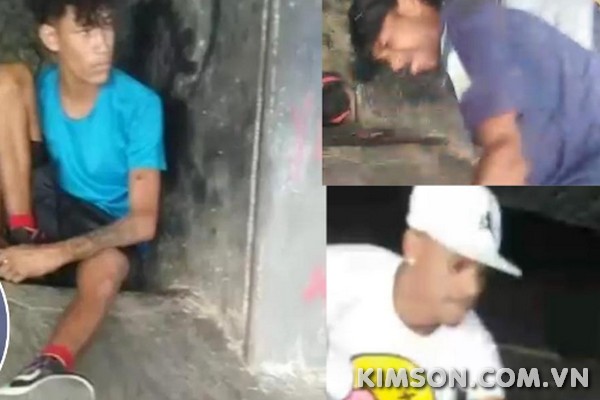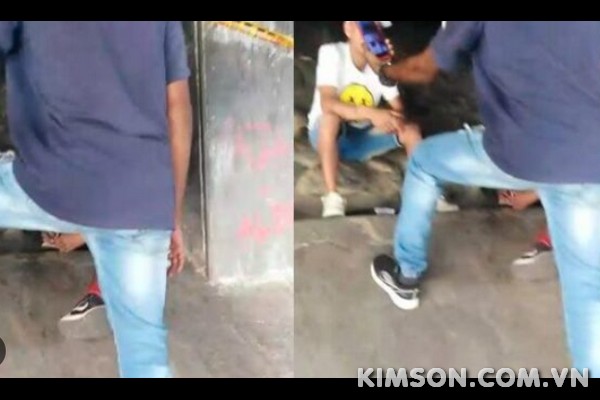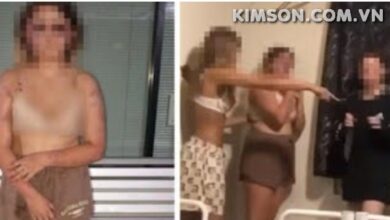[Watch Video] De joven venezolano de 22 años en Cucuta Colombia Twitter

Kimson.com.vn presenta un análisis profundo del estremecedor “Video de joven venezolano de 22 años en Cucuta Colombia Twitter“, una grabación que ha circulado ampliamente en las redes sociales, provocando una oleada de conmoción y denuncia. “Watch Video de joven venezolano de 22 años en Cucuta Colombia Twitter: Shocking Footage Circulates on Social Media” revela cómo este contenido viral ha puesto de manifiesto la crudeza de la violencia urbana y el desafío que representa el microtráfico en Cúcuta. El “Video de joven venezolano de 22 años en Cucuta Colombia Twitter (Viral Watch Video)” y “Colombia Cucuta Video Twitter – Video De Joven Venezolano De 22 Años Completo” no solo muestran un incidente aislado, sino que exponen la lucha diaria y las sombras que acechan en la vida cotidiana de la ciudad. Este artículo invita a reflexionar sobre la realidad y las reacciones de una comunidad que, unida en el dolor y la determinación, busca superar esta tragedia y encontrar la justicia.

I. The Viral Outbreak of a Tragedy
In the shadow of Eustorgio Colmenares Bridge in Cúcuta, Colombia, a tragedy unfurled that would soon grip the world through a viral phenomenon—the “Video de joven venezolano de 22 años en Cucuta Colombia Twitter.” Captured in this video was a harrowing act of violence: a 22-year-old Venezuelan man brutally attacked, his pleas for mercy falling on deaf ears as indifferent onlookers chose to record the atrocity rather than intervene. This chilling bystander effect not only highlighted the desensitization to violence but also the disturbing inclination to share such moments of human suffering online.
As the video spread like wildfire across social media platforms, tagged “Watch Video de joven venezolano de 22 años en Cucuta Colombia Twitter,” the public’s shock and outrage grew exponentially. The footage did not just document a violent crime; it served as a stark representation of the societal and moral issues plaguing the city. Citizens and authorities alike were jolted into a state of high alert, with the latter initiating a quest for justice. The authorities swiftly announced a substantial reward for information leading to the capture of the assailant, signaling the beginning of an aggressive crackdown on the lawlessness that had led to this moment.
The video, thus, catalyzed a broader conversation about crime, punishment, and the role of social media in the dissemination of violent content. It underscored the urgent need for community solidarity and effective law enforcement strategies to address the underlying causes of such brutal acts and prevent their recurrence.
II. The Faces of Violence in Cúcuta
Cúcuta, Colombia, a city where the bustling streets mask a grim undercurrent of socio-economic struggles, has become a fertile ground for microtrafficking, a catalyst for crime that preys on the desperation and vulnerability of its populace. The narcotics trade has woven itself into the fabric of daily life, offering illicit paths to those seeking escape from poverty or unemployment. This backdrop sets the stage for the tragedies that unfold within the city, where survival often intersects with the law’s shadowy margins.
Within this turbulent landscape emerged the story of “Lágrimas,” a nickname that carried a haunting irony for a young Venezuelan man whose life was marred by the very violence that his moniker lamented. The “Colombia Cucuta Video Twitter – Video De Joven Venezolano De 22 Años Completo” laid bare the final moments of “Lágrimas,” his life cruelly cut short under the unflinching lens of a bystander’s camera. His identity became emblematic of the countless individuals caught in the relentless cycle of violence that microtrafficking engenders.
The video’s circulation did more than document a brutal act; it underscored the human cost of Cúcuta’s illicit trade. “Lágrimas” was not just a victim of personal misfortune but a representation of a society grappling with systemic issues that perpetuate crime and suffering. His story compelled the city to confront the stark reality of its struggles and to recognize the faces of those who bear the brunt of its consequences.

III. The Authorities’ Battle Against Crime
In the wake of the brutality captured in the viral video, local law enforcement in Cúcuta has been galvanized into action, recognizing the need to staunch the bleeding of public trust and safety. With a determined resolve, authorities have unveiled a multifaceted approach aimed at dismantling the networks of crime that cast long shadows over the city’s streets. Central to their strategy is the implementation of reward plans, offering financial incentives for information that could lead to the apprehension and conviction of those responsible for the heinous acts depicted in the video. This initiative serves as a beacon of hope, signaling to the community that justice is not only sought but is actively being pursued.
Simultaneously, investigation strategies have been intensified, leveraging state-of-the-art forensics and intelligence gathering to penetrate the veil of criminal anonymity. The authorities have made it clear that the fight against crime is as much about prevention as it is about prosecution, with efforts being made to disrupt the cycle of violence before it claims more lives.
Parallel to these law enforcement endeavors, there has been a public appeal from both community leaders and authorities to combat the spread of the video. This call to moral action underscores the collective responsibility to protect the dignity of victims and to prevent the glorification of violence. The community is urged to refrain from sharing the graphic content, a gesture that, while seemingly small, can contribute to a larger cultural shift away from sensationalism and towards empathy and proactive citizenship. The shared goal is clear: to forge a future for Cúcuta where safety is restored and peace is more than a fleeting dream.
IV. The Underlying Issue: Microtrafficking
The drug trade’s insidious grip on Cúcuta has exposed the dark underbelly of a city struggling against the tides of microtrafficking. This illicit enterprise has not only fueled a black-market economy but has also entrenched a culture of violence and fear. The narcotics business thrives on the exploitation of Cúcuta’s strategic position along the border, turning it into a nerve center for the distribution of contraband substances. As dealers weave through the social fabric of the city, they leave in their wake a trail of corruption, intimidation, and death, revealing a community held hostage by the very forces that promise false prosperity.
In response to the escalating crisis, official statements and actions have been forthcoming, with the city’s leadership stepping into the fray. The viral circulation of the “Video de joven venezolano de 22 años en Cucuta Colombia Twitter (Viral Watch Video)” prompted a decisive condemnation from the Mayor’s office. Recognizing the urgency of the moment, the Mayor has taken a firm stance against the perpetrators of such crimes and the broader issue of microtrafficking. The administration’s commitments have been outlined in public addresses, detailing a series of actions intended to reclaim the streets from the clutches of the drug trade.
These actions include bolstering law enforcement capabilities, enhancing social programs to provide alternatives to criminal activities, and fostering regional partnerships aimed at stifling the cross-border flow of drugs. The Mayor’s approach underscores a recognition that the battle against microtrafficking necessitates a holistic strategy, one that combines the force of law with the power of community resilience. Only through a concerted and sustained effort can the tide of narcotics-related crime be turned back, restoring Cúcuta to a place where its citizens can thrive free from the shadows of an illicit economy.

The proliferation of crime videos on social media has shifted the dynamics of crime and punishment, propelling incidents from obscurity to infamy within the span of a few clicks. The power of a viral video, as seen in the case of the “Video de joven venezolano de 22 años en Cucuta Colombia Twitter,” can ignite a public discourse that transcends borders, drawing attention to societal ills that may have otherwise remained in the shadows. However, this same power also raises ethical concerns about the desensitization to violence and the potential for such content to perpetuate cycles of trauma.
In response to the viral nature of crime videos, communities and authorities have begun to craft a dual strategy. On one side, there is an emphasis on utilizing the reach of social media to rally support and aid law enforcement efforts. Information dissemination has become a tool for justice, aiding in the swift capture of suspects and the mobilization of community vigilance.
Simultaneously, there is a strong reaction from both the community and authorities to counteract the negative effects of such triggering content. A community united in grief and determination has begun to call for platforms to take responsibility for the content shared and for individuals to exercise restraint, prioritizing empathy over curiosity. Authorities have echoed this sentiment, urging the public to respect the privacy of victims and their families and to refrain from sharing graphic imagery.
This collective response reflects a growing awareness of the responsibility that comes with digital citizenship. It is a call to balance the need for awareness and action with respect for human dignity, fostering a digital landscape where the focus shifts from sensationalism to solution-oriented collaboration.
Closing Paragraph
Through the lens of “Video de joven venezolano de 22 años en Cucuta Colombia Twitter,” we are confronted with the stark truth of violence that overshadows the everyday life of Cúcuta’s citizens. The viral spread of this tragic footage serves as a sobering reminder of the urgency with which we must address the underlying issues fueling such brutality. As the city collectively seeks solace and solutions, it is paramount that every echo of outrage translates into concrete actions for a safer tomorrow.
FAQ
1: What is “Video de joven venezolano de 22 años en Cucuta Colombia Twitter”? A: It refers to a viral video that captures the heinous murder of a 22-year-old Venezuelan man in Cúcuta, which has caused widespread shock and outrage.
2: Why has “Watch Video de joven venezolano de 22 años en Cucuta Colombia Twitter” become significant? A: The video has become significant as it has brought national attention to the issues of microtrafficking and gang violence in Cúcuta through its shocking content and rapid spread on social media.
3: How has the “Colombia Cucuta Video Twitter” impacted the local community? A: The complete video, referred to as “Colombia Cucuta Video Twitter,” has impacted the community by highlighting the grim reality of violence in the area and sparking a call to action against crime and microtrafficking.
4: What has been the reaction to the “Video de joven venezolano de 22 años en Cucuta Colombia Twitter (Viral Watch Video)”? A: The reaction to the viral watch video has been one of horror and a unified demand for justice, with authorities and the community calling for swift action to apprehend those responsible for the crime.




